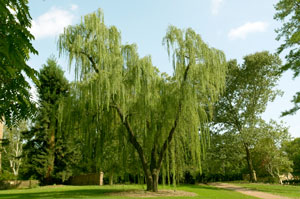 |
Natalie from Sigurd, UT
Willow trees are fast growing, graceful, and dramatic, which is why they tend to be popular choices among homeowners. Unfortunately, their growing habits are not very well suited to an urban landscape. The answer to your question on a safe planting distance depends on how far away the roots need to grow to access water.
Weeping willows are water lovers, and therefore their roots are experts at seeking out reservoirs of water. This tree actually likes to stand in water, which is why in the wild, they are commonly found growing along the banks of rivers and streams, and near wetlands. Weeping willows grow to a height of 35 to 50 feet, but their roots are capable of venturing out much farther than the spread of their branches in order to find water.
Most tree experts (and I am not a tree expert) agree that trees known for roots that seek out water, such as poplar, maple, willow, and elm, should be planted at least 50 feet from septic mounds. To confirm this, I checked with my county extension agency and they agreed with that recommendation. From your description, it sounds as though your weeping willow is separated from your septic tank and drain field by your house. That is a good thing. A bigger concern for you is your foundation, and where in relation to the location of your tree, your water and sewer pipes enter and exit your home. The nutrient-rich water from leaky sewer pipes or cracked water lines can act like a magnet for wandering roots. On the bright side, as long as the roots have enough room to spread out, a solid structure like your foundation should divert the direction of their growth, providing that that nearby water or sewer pipes are in good repair, and you don't have problems with moisture pooling around your foundation.
Help keep the tree's roots away from your foundation by keeping water away from it. Build up the soil around your foundation so that it slopes away from your house, and use rain gutters to divert the flow of water away from your foundation.
Good luck.
Ellen
About The Author: Ellen Brown is an environmental writer and photographer and the owner of Sustainable Media, an environmental media company that specializes in helping businesses and organizations promote eco-friendly products and services. Contact her on the web at http://www.sustainable-media.com
Its not good to plant any type of tree near your septic tank. The roots grow up into the pipes that make up the drain field. I know where my drain field for the septic tank is located because I build the house and was here when it was installed. We made the mistake of planting poplar trees along the front of our property and roots grew into the drainfield's pipes. I have to wait for them to rot. (sigh) So I am saying that you should not only consider the septic tank, but the septic tank's drain field as well.
Then there is the matter of planting trees too close to the house. This is something most people are guilty of doing. Not only do the roots push against the foundation, but also sometimes the leaves prevent sun from reaching the roof and moss grows on the roof. (Yep, I have woods too close to my house.)
Overall, I suggest you read about the variety of tree you want to plant to find out how tall and wide it will be when it reaches maturity. I think you can pretty much tell how far the roots will reach by using the outermost tips of the branches as a guide. I think the tree extends underground about as far as it does above ground. So if your tree grows to be 20' tall and 20' wide, you can plan on the roots to extend that far as well.
Trees are good and I've read they add 10 % to the value of your property (your house). They protect the house from winds and help save on heating and air conditioning. So when you plant a tree you will also want to consider what directions storms come where you live. Where I live the storms always come from the West. (That is the side of the house where rain will come in windows if they are left open.) So that is the side of the house where I need to have trees planted.
I hope this message is of some help to you. (04/18/2008)
By Carol in PA
Add your voice! Click below to comment. ThriftyFun is powered by your wisdom!